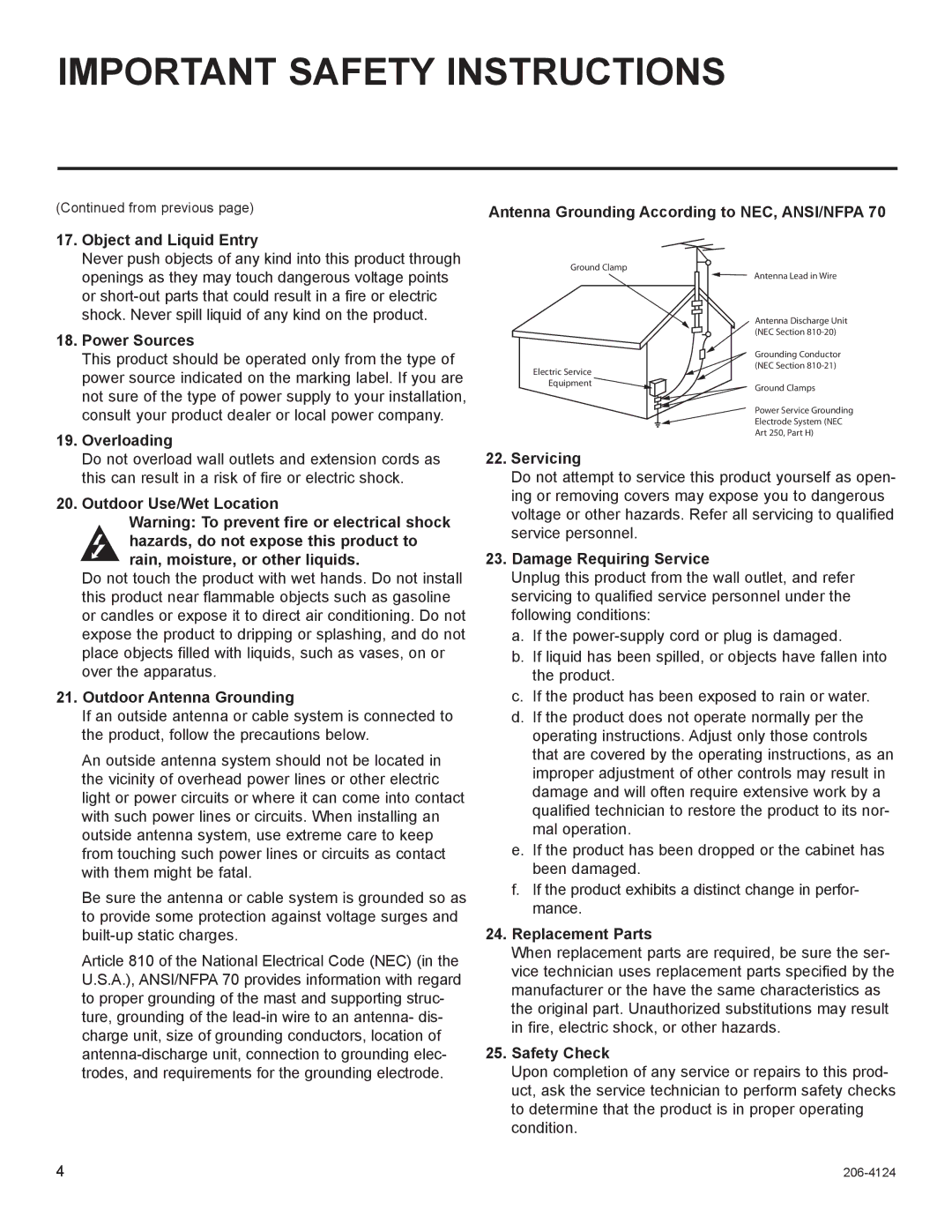
IMPORTANT SAFETY INSTRUCTIONS
(Continued from previous page)
17.Object and Liquid Entry
Never push objects of any kind into this product through openings as they may touch dangerous voltage points or
18.Power Sources
This product should be operated only from the type of power source indicated on the marking label. If you are not sure of the type of power supply to your installation, consult your product dealer or local power company.
19.Overloading
Do not overload wall outlets and extension cords as this can result in a risk of fire or electric shock.
20.Outdoor Use/Wet Location
Warning: To prevent fire or electrical shock hazards, do not expose this product to rain, moisture, or other liquids.
Do not touch the product with wet hands. Do not install this product near flammable objects such as gasoline or candles or expose it to direct air conditioning. Do not expose the product to dripping or splashing, and do not place objects filled with liquids, such as vases, on or over the apparatus.
21.Outdoor Antenna Grounding
If an outside antenna or cable system is connected to the product, follow the precautions below.
An outside antenna system should not be located in the vicinity of overhead power lines or other electric light or power circuits or where it can come into contact with such power lines or circuits. When installing an outside antenna system, use extreme care to keep from touching such power lines or circuits as contact with them might be fatal.
Be sure the antenna or cable system is grounded so as to provide some protection against voltage surges and
Article 810 of the National Electrical Code (NEC) (in the U.S.A.), ANSI/NFPA 70 provides information with regard to proper grounding of the mast and supporting struc- ture, grounding of the
Antenna Grounding According to NEC, ANSI/NFPA 70
Ground Clamp | Antenna Lead in Wire |
| |
| Antenna Discharge Unit |
| (NEC Section |
| Grounding Conductor |
Electric Service | (NEC Section |
| |
Equipment | Ground Clamps |
| |
| Power Service Grounding |
| Electrode System (NEC |
| Art 250, Part H) |
22.Servicing
Do not attempt to service this product yourself as open- ing or removing covers may expose you to dangerous voltage or other hazards. Refer all servicing to qualified service personnel.
23.Damage Requiring Service
Unplug this product from the wall outlet, and refer servicing to qualified service personnel under the following conditions:
a.If the
b.If liquid has been spilled, or objects have fallen into the product.
c.If the product has been exposed to rain or water.
d.If the product does not operate normally per the operating instructions. Adjust only those controls that are covered by the operating instructions, as an improper adjustment of other controls may result in damage and will often require extensive work by a qualified technician to restore the product to its nor- mal operation.
e.If the product has been dropped or the cabinet has been damaged.
f.If the product exhibits a distinct change in perfor- mance.
24.Replacement Parts
When replacement parts are required, be sure the ser- vice technician uses replacement parts specified by the manufacturer or the have the same characteristics as the original part. Unauthorized substitutions may result in fire, electric shock, or other hazards.
25.Safety Check
Upon completion of any service or repairs to this prod- uct, ask the service technician to perform safety checks to determine that the product is in proper operating condition.
4 |
